Physiological Principles: Cardiovascular, Skeletal, Muscular Systems
VerifiedAdded on 2020/07/22
|20
|7196
|163
Report
AI Summary
This report provides an in-depth exploration of human physiology, focusing on the anatomy and function of the cardiovascular, skeletal, and muscular systems. It details the structure and roles of each system, including bones, joints, muscles, and blood vessels, and explains how these systems interact to maintain overall body functionality. The report also discusses the importance of these systems in health and social care settings, emphasizing the interconnectedness of body systems and their responses to internal and external environmental changes. Additionally, the report touches on the measurement techniques used to assess body functioning and the impact of diseases and disorders on normal physiological processes. This assignment offers a comprehensive overview of key physiological principles relevant to healthcare and social care practices.
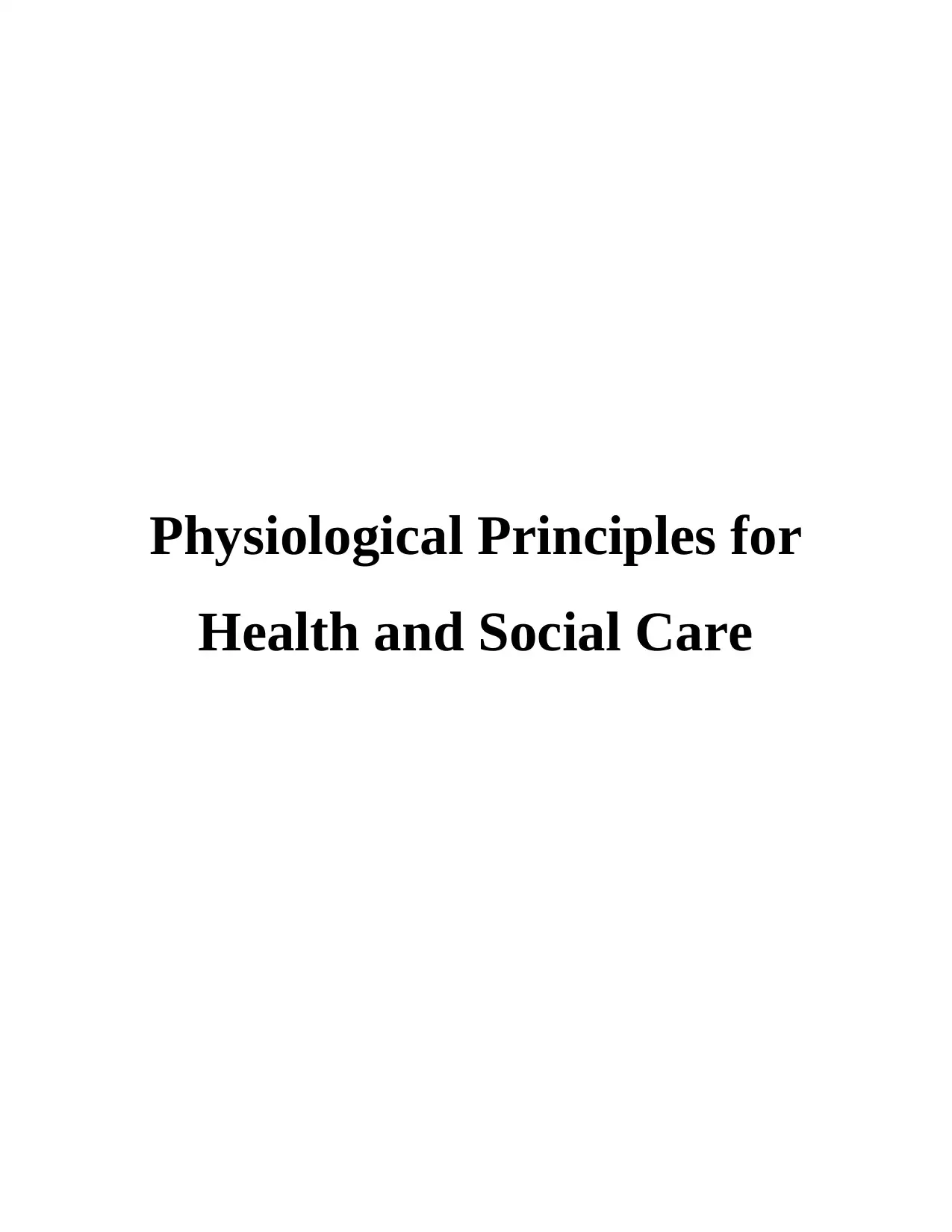
Physiological Principles for
Health and Social Care
Health and Social Care
Paraphrase This Document
Need a fresh take? Get an instant paraphrase of this document with our AI Paraphraser
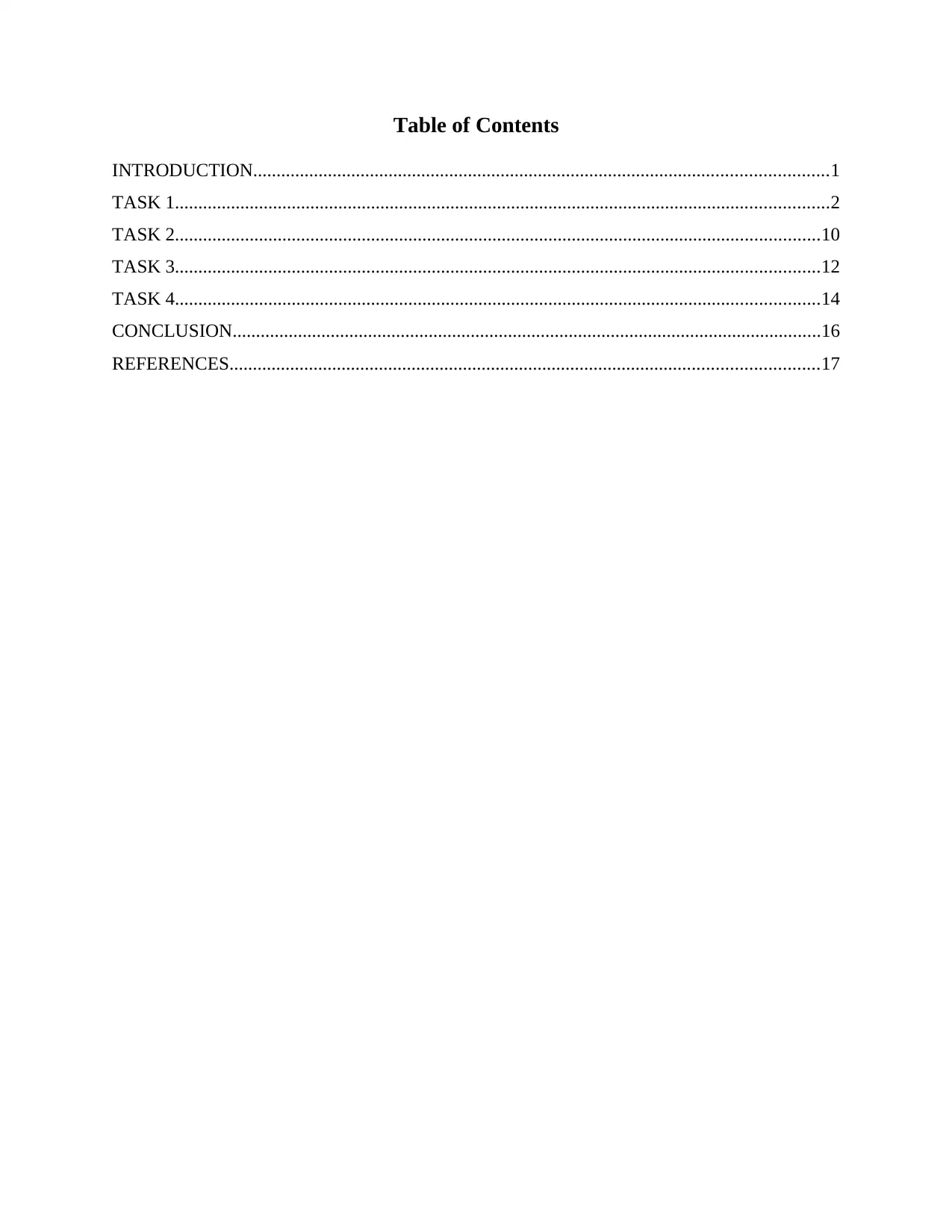
Table of Contents
INTRODUCTION...........................................................................................................................1
TASK 1............................................................................................................................................2
TASK 2..........................................................................................................................................10
TASK 3..........................................................................................................................................12
TASK 4..........................................................................................................................................14
CONCLUSION..............................................................................................................................16
REFERENCES..............................................................................................................................17
INTRODUCTION...........................................................................................................................1
TASK 1............................................................................................................................................2
TASK 2..........................................................................................................................................10
TASK 3..........................................................................................................................................12
TASK 4..........................................................................................................................................14
CONCLUSION..............................................................................................................................16
REFERENCES..............................................................................................................................17
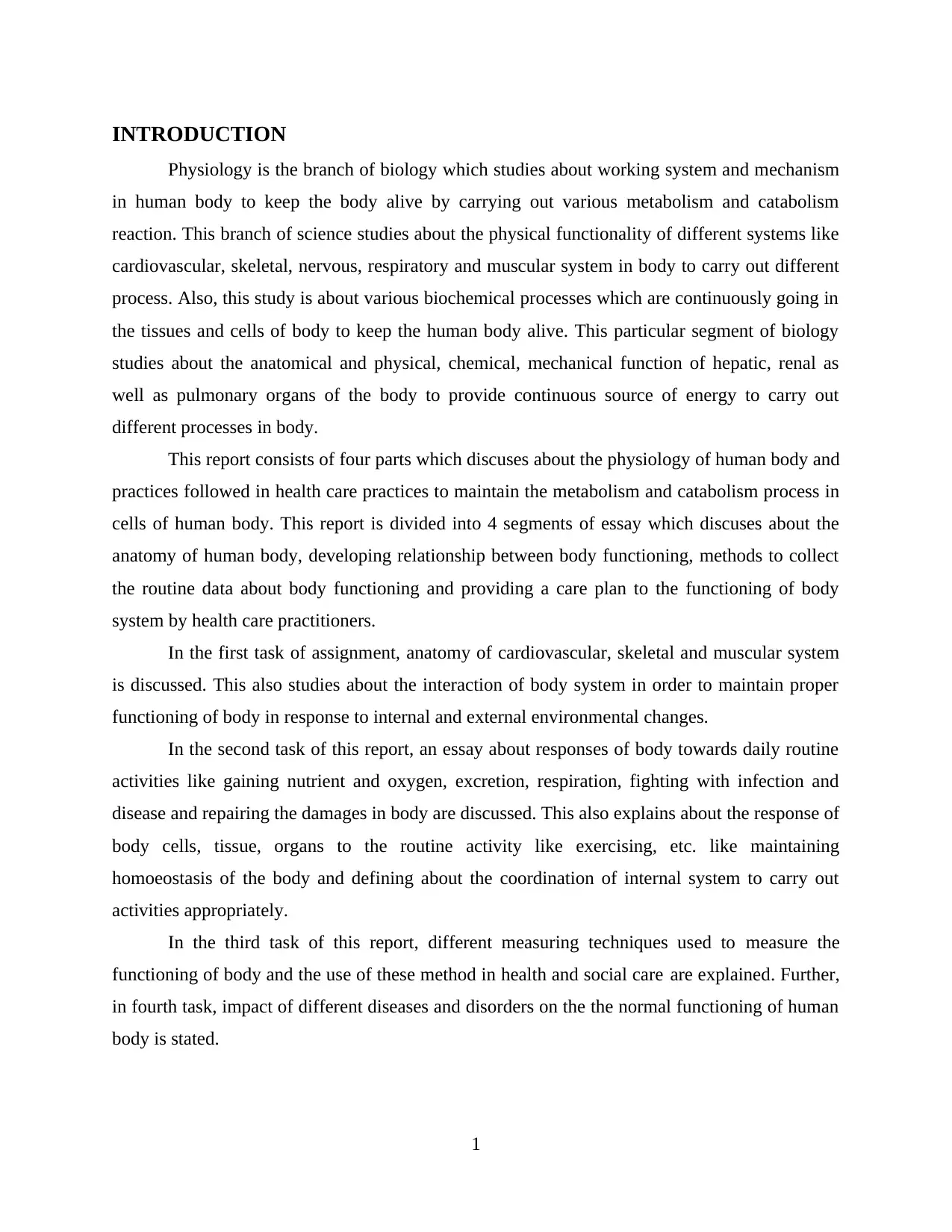
INTRODUCTION
Physiology is the branch of biology which studies about working system and mechanism
in human body to keep the body alive by carrying out various metabolism and catabolism
reaction. This branch of science studies about the physical functionality of different systems like
cardiovascular, skeletal, nervous, respiratory and muscular system in body to carry out different
process. Also, this study is about various biochemical processes which are continuously going in
the tissues and cells of body to keep the human body alive. This particular segment of biology
studies about the anatomical and physical, chemical, mechanical function of hepatic, renal as
well as pulmonary organs of the body to provide continuous source of energy to carry out
different processes in body.
This report consists of four parts which discuses about the physiology of human body and
practices followed in health care practices to maintain the metabolism and catabolism process in
cells of human body. This report is divided into 4 segments of essay which discuses about the
anatomy of human body, developing relationship between body functioning, methods to collect
the routine data about body functioning and providing a care plan to the functioning of body
system by health care practitioners.
In the first task of assignment, anatomy of cardiovascular, skeletal and muscular system
is discussed. This also studies about the interaction of body system in order to maintain proper
functioning of body in response to internal and external environmental changes.
In the second task of this report, an essay about responses of body towards daily routine
activities like gaining nutrient and oxygen, excretion, respiration, fighting with infection and
disease and repairing the damages in body are discussed. This also explains about the response of
body cells, tissue, organs to the routine activity like exercising, etc. like maintaining
homoeostasis of the body and defining about the coordination of internal system to carry out
activities appropriately.
In the third task of this report, different measuring techniques used to measure the
functioning of body and the use of these method in health and social care are explained. Further,
in fourth task, impact of different diseases and disorders on the the normal functioning of human
body is stated.
1
Physiology is the branch of biology which studies about working system and mechanism
in human body to keep the body alive by carrying out various metabolism and catabolism
reaction. This branch of science studies about the physical functionality of different systems like
cardiovascular, skeletal, nervous, respiratory and muscular system in body to carry out different
process. Also, this study is about various biochemical processes which are continuously going in
the tissues and cells of body to keep the human body alive. This particular segment of biology
studies about the anatomical and physical, chemical, mechanical function of hepatic, renal as
well as pulmonary organs of the body to provide continuous source of energy to carry out
different processes in body.
This report consists of four parts which discuses about the physiology of human body and
practices followed in health care practices to maintain the metabolism and catabolism process in
cells of human body. This report is divided into 4 segments of essay which discuses about the
anatomy of human body, developing relationship between body functioning, methods to collect
the routine data about body functioning and providing a care plan to the functioning of body
system by health care practitioners.
In the first task of assignment, anatomy of cardiovascular, skeletal and muscular system
is discussed. This also studies about the interaction of body system in order to maintain proper
functioning of body in response to internal and external environmental changes.
In the second task of this report, an essay about responses of body towards daily routine
activities like gaining nutrient and oxygen, excretion, respiration, fighting with infection and
disease and repairing the damages in body are discussed. This also explains about the response of
body cells, tissue, organs to the routine activity like exercising, etc. like maintaining
homoeostasis of the body and defining about the coordination of internal system to carry out
activities appropriately.
In the third task of this report, different measuring techniques used to measure the
functioning of body and the use of these method in health and social care are explained. Further,
in fourth task, impact of different diseases and disorders on the the normal functioning of human
body is stated.
1
⊘ This is a preview!⊘
Do you want full access?
Subscribe today to unlock all pages.

Trusted by 1+ million students worldwide

TASK 1
Anatomy of human body and different systems of body- The anatomy is the study of
structure of the living beings. While defining the anatomy of human body, it comprise of head,
limbs, abdomen, trunk body, pelvis, having soft tissue, nervous system and secretory as well as
absorptive epithelial tissue, different body organs like heart, lungs, liver and kidney which works
in an integration system to carry out basic routine activities effectively like respiration, response
towards stimulus, excretion, digestion, locomotion, etc. Some of the anatomical structure of
different body systems is discussed along with studying about their function in body and
integration in roles.
Skeletal system:
Skeletal structure of the human body includes bones and joints which support it and also
protects soft tissue of body and helps in movements. Skeletal system defines the structure of the
body. It comprises of the limbic bones and skull. This also includes a system which is associated
with the bones of body and various functions like formation of RBC in bone marrow. This is
acting as reservoir of calcium in body and providing support to ligaments and muscle in order to
carry out locomotion effectively.
The skeletal system is made up of total 206 bones in a human body. These bones are
divided in different categories depending upon the part of axial or appendicular skeleton system.
The axial skeletal system consists of 80 bones including bones of skull (22), Hyoid bone which
is floating bone of body (1), ear ossicles (3), Ribs (12 pairs), vertebral column (26) and sternum
(1). Vertebral column is formed by 26 vertebra column which are named as Cervical (7
vertebra), Thoracic (12), Lumbar (5), Sacrum (1), Coccyx (1) of While appendicular skeletal is
made up of 126 bones consisting of bones of upper limbs, lower limbs, pelvic and pectoral
girdle. Pelvic girdle and Lower limb is formed from 2 pair of hip bone, femur, tibia, patella,
fibula, talus, 7 tarsal forming foot, 5 metatarsal and phalanges (14). While pectoral girdle i.e.
shoulder bone and upper limbs consist of 2 clavicles and 2 scapulae bones, Humerus (1), radius
and ulna forming forearm, carpals (8), metacarpals, 3 phalanges in each finger and 2 phalanges
in thumb.
2
Anatomy of human body and different systems of body- The anatomy is the study of
structure of the living beings. While defining the anatomy of human body, it comprise of head,
limbs, abdomen, trunk body, pelvis, having soft tissue, nervous system and secretory as well as
absorptive epithelial tissue, different body organs like heart, lungs, liver and kidney which works
in an integration system to carry out basic routine activities effectively like respiration, response
towards stimulus, excretion, digestion, locomotion, etc. Some of the anatomical structure of
different body systems is discussed along with studying about their function in body and
integration in roles.
Skeletal system:
Skeletal structure of the human body includes bones and joints which support it and also
protects soft tissue of body and helps in movements. Skeletal system defines the structure of the
body. It comprises of the limbic bones and skull. This also includes a system which is associated
with the bones of body and various functions like formation of RBC in bone marrow. This is
acting as reservoir of calcium in body and providing support to ligaments and muscle in order to
carry out locomotion effectively.
The skeletal system is made up of total 206 bones in a human body. These bones are
divided in different categories depending upon the part of axial or appendicular skeleton system.
The axial skeletal system consists of 80 bones including bones of skull (22), Hyoid bone which
is floating bone of body (1), ear ossicles (3), Ribs (12 pairs), vertebral column (26) and sternum
(1). Vertebral column is formed by 26 vertebra column which are named as Cervical (7
vertebra), Thoracic (12), Lumbar (5), Sacrum (1), Coccyx (1) of While appendicular skeletal is
made up of 126 bones consisting of bones of upper limbs, lower limbs, pelvic and pectoral
girdle. Pelvic girdle and Lower limb is formed from 2 pair of hip bone, femur, tibia, patella,
fibula, talus, 7 tarsal forming foot, 5 metatarsal and phalanges (14). While pectoral girdle i.e.
shoulder bone and upper limbs consist of 2 clavicles and 2 scapulae bones, Humerus (1), radius
and ulna forming forearm, carpals (8), metacarpals, 3 phalanges in each finger and 2 phalanges
in thumb.
2
Paraphrase This Document
Need a fresh take? Get an instant paraphrase of this document with our AI Paraphraser

All bones form different type of joints where some are moveable while some are
immovable. These different types of joints provide movements to the body parts. various types of
joints formed between the bones are fibrous, cartilaginous, Synovial, Hinge, ball and socket joint
present in hip and shoulder joints, pivot joint this provides multidirectional movement present
between atlas and axis (neck joint), gliding, saddle, planar provides movement in only one
direction, sutures totally immovable, Syndesmoses which are slight moveable joint.
Functions of skeletal system in human body is to protect the soft tissue and organs of
human beings. Brain and heart are protected from external damage. Brain is present in a solid
bone cavity which protects brain of human beings from external injuries. Heart and lungs are
also present in the rib cage which protects heart and also, prevent the over expansion of lungs.
Another function of skeletal muscle in human body is providing support to internal system. The
lower limb bones render help to muscles and anchor muscles in bones to provide a support to
locomotion of body. Different types of skeletal muscles provides movement to the body. Skeletal
system is also having function of storing high amount of calcium in bones and also reservoir for
the RBC production in longer bones of body. The leg bone femur consists of bone where Red
3
Illustration 1: Skeletal system 2017
Source 1: The Skeletal System.
2017.
immovable. These different types of joints provide movements to the body parts. various types of
joints formed between the bones are fibrous, cartilaginous, Synovial, Hinge, ball and socket joint
present in hip and shoulder joints, pivot joint this provides multidirectional movement present
between atlas and axis (neck joint), gliding, saddle, planar provides movement in only one
direction, sutures totally immovable, Syndesmoses which are slight moveable joint.
Functions of skeletal system in human body is to protect the soft tissue and organs of
human beings. Brain and heart are protected from external damage. Brain is present in a solid
bone cavity which protects brain of human beings from external injuries. Heart and lungs are
also present in the rib cage which protects heart and also, prevent the over expansion of lungs.
Another function of skeletal muscle in human body is providing support to internal system. The
lower limb bones render help to muscles and anchor muscles in bones to provide a support to
locomotion of body. Different types of skeletal muscles provides movement to the body. Skeletal
system is also having function of storing high amount of calcium in bones and also reservoir for
the RBC production in longer bones of body. The leg bone femur consists of bone where Red
3
Illustration 1: Skeletal system 2017
Source 1: The Skeletal System.
2017.

blood cells are produced which is an important function of skeletal system of human body. This
process is known as haematopoiesis. This skeletal system also contributes in the growth and
development of body by supporting storage of various minerals salts and fat in muscles, etc.
Muscular system:
Muscular system consists of all the muscles of body which is connected with different
organs or the skeletal bones of the body having different function which are categorised in
different types depending upon their name, origin, location, shape and size of muscle. There are
three of muscles which have different function and roles in body. The various muscles are
skeletal, smooth and cardiac (Cowles, 2012). The primary function of the muscular system is to
provide movement by working in integration with the skeletal bones. But the muscles also helps
in heart to beat and present in the inner lining walls of hollow organs. The different type of
muscles consisting the muscular system of the human body are discussed below.
Smooth muscles are present in the inner wall of the hollow organs like stomach, intestine,
respiratory passage, inner walls of blood vessels. These muscles are smooth in appearance as
contrasting to the skeletal and cardiac muscular tissues which are striated (Thoits, 2011). The
movement of these smooth muscles helps in propelling the gases through respiratory track,
passage of food in alimentary canal and urine from renal vessels and blood through arteries and
veins. These muscles are involuntary muscles and not controlled by brain conscious.
4
Illustration 2: Muscular system, 2017
Source 2: Skeletal muscle structure and function. 2017.
process is known as haematopoiesis. This skeletal system also contributes in the growth and
development of body by supporting storage of various minerals salts and fat in muscles, etc.
Muscular system:
Muscular system consists of all the muscles of body which is connected with different
organs or the skeletal bones of the body having different function which are categorised in
different types depending upon their name, origin, location, shape and size of muscle. There are
three of muscles which have different function and roles in body. The various muscles are
skeletal, smooth and cardiac (Cowles, 2012). The primary function of the muscular system is to
provide movement by working in integration with the skeletal bones. But the muscles also helps
in heart to beat and present in the inner lining walls of hollow organs. The different type of
muscles consisting the muscular system of the human body are discussed below.
Smooth muscles are present in the inner wall of the hollow organs like stomach, intestine,
respiratory passage, inner walls of blood vessels. These muscles are smooth in appearance as
contrasting to the skeletal and cardiac muscular tissues which are striated (Thoits, 2011). The
movement of these smooth muscles helps in propelling the gases through respiratory track,
passage of food in alimentary canal and urine from renal vessels and blood through arteries and
veins. These muscles are involuntary muscles and not controlled by brain conscious.
4
Illustration 2: Muscular system, 2017
Source 2: Skeletal muscle structure and function. 2017.
⊘ This is a preview!⊘
Do you want full access?
Subscribe today to unlock all pages.

Trusted by 1+ million students worldwide
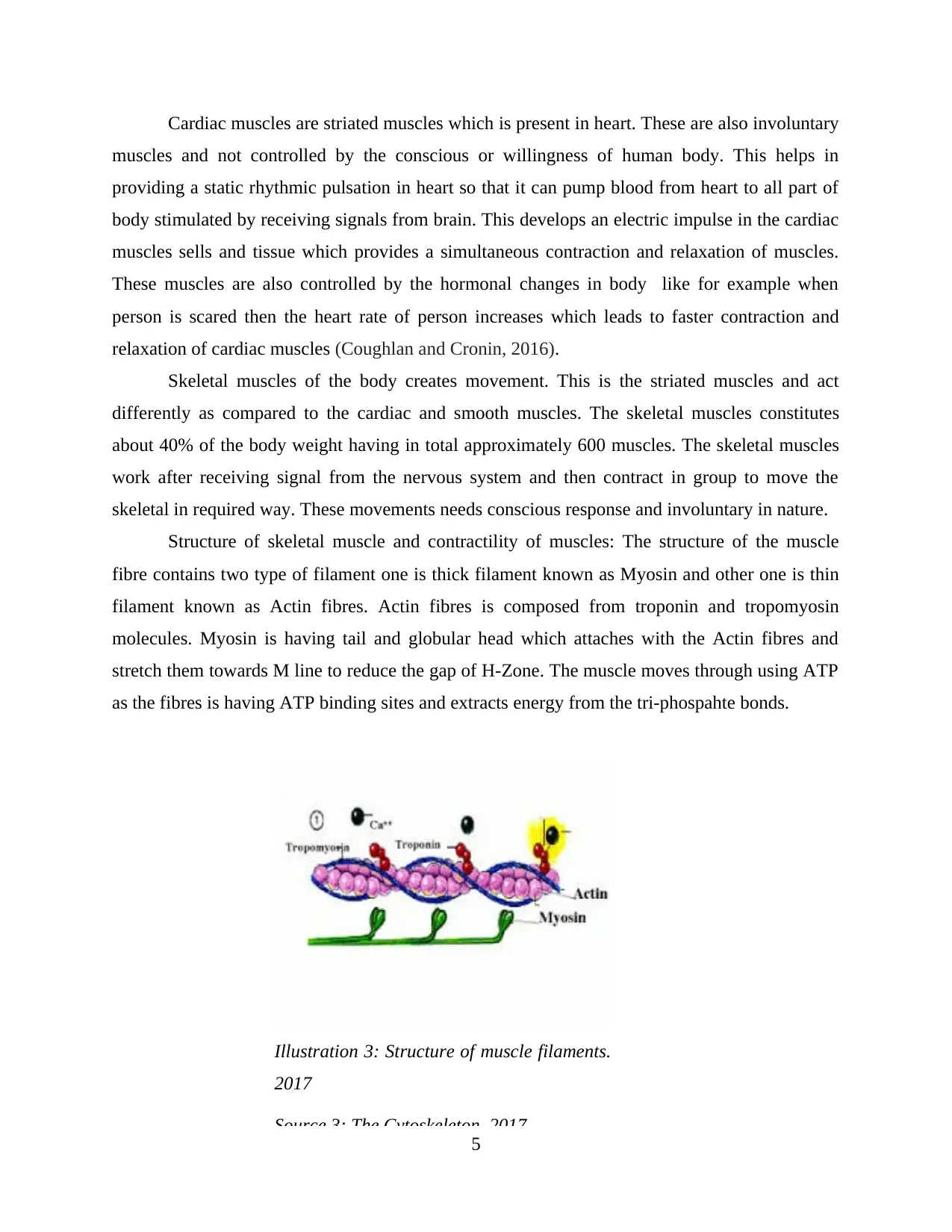
Cardiac muscles are striated muscles which is present in heart. These are also involuntary
muscles and not controlled by the conscious or willingness of human body. This helps in
providing a static rhythmic pulsation in heart so that it can pump blood from heart to all part of
body stimulated by receiving signals from brain. This develops an electric impulse in the cardiac
muscles sells and tissue which provides a simultaneous contraction and relaxation of muscles.
These muscles are also controlled by the hormonal changes in body like for example when
person is scared then the heart rate of person increases which leads to faster contraction and
relaxation of cardiac muscles (Coughlan and Cronin, 2016).
Skeletal muscles of the body creates movement. This is the striated muscles and act
differently as compared to the cardiac and smooth muscles. The skeletal muscles constitutes
about 40% of the body weight having in total approximately 600 muscles. The skeletal muscles
work after receiving signal from the nervous system and then contract in group to move the
skeletal in required way. These movements needs conscious response and involuntary in nature.
Structure of skeletal muscle and contractility of muscles: The structure of the muscle
fibre contains two type of filament one is thick filament known as Myosin and other one is thin
filament known as Actin fibres. Actin fibres is composed from troponin and tropomyosin
molecules. Myosin is having tail and globular head which attaches with the Actin fibres and
stretch them towards M line to reduce the gap of H-Zone. The muscle moves through using ATP
as the fibres is having ATP binding sites and extracts energy from the tri-phospahte bonds.
5
Illustration 3: Structure of muscle filaments.
2017
Source 3: The Cytoskeleton. 2017.
muscles and not controlled by the conscious or willingness of human body. This helps in
providing a static rhythmic pulsation in heart so that it can pump blood from heart to all part of
body stimulated by receiving signals from brain. This develops an electric impulse in the cardiac
muscles sells and tissue which provides a simultaneous contraction and relaxation of muscles.
These muscles are also controlled by the hormonal changes in body like for example when
person is scared then the heart rate of person increases which leads to faster contraction and
relaxation of cardiac muscles (Coughlan and Cronin, 2016).
Skeletal muscles of the body creates movement. This is the striated muscles and act
differently as compared to the cardiac and smooth muscles. The skeletal muscles constitutes
about 40% of the body weight having in total approximately 600 muscles. The skeletal muscles
work after receiving signal from the nervous system and then contract in group to move the
skeletal in required way. These movements needs conscious response and involuntary in nature.
Structure of skeletal muscle and contractility of muscles: The structure of the muscle
fibre contains two type of filament one is thick filament known as Myosin and other one is thin
filament known as Actin fibres. Actin fibres is composed from troponin and tropomyosin
molecules. Myosin is having tail and globular head which attaches with the Actin fibres and
stretch them towards M line to reduce the gap of H-Zone. The muscle moves through using ATP
as the fibres is having ATP binding sites and extracts energy from the tri-phospahte bonds.
5
Illustration 3: Structure of muscle filaments.
2017
Source 3: The Cytoskeleton. 2017.
Paraphrase This Document
Need a fresh take? Get an instant paraphrase of this document with our AI Paraphraser
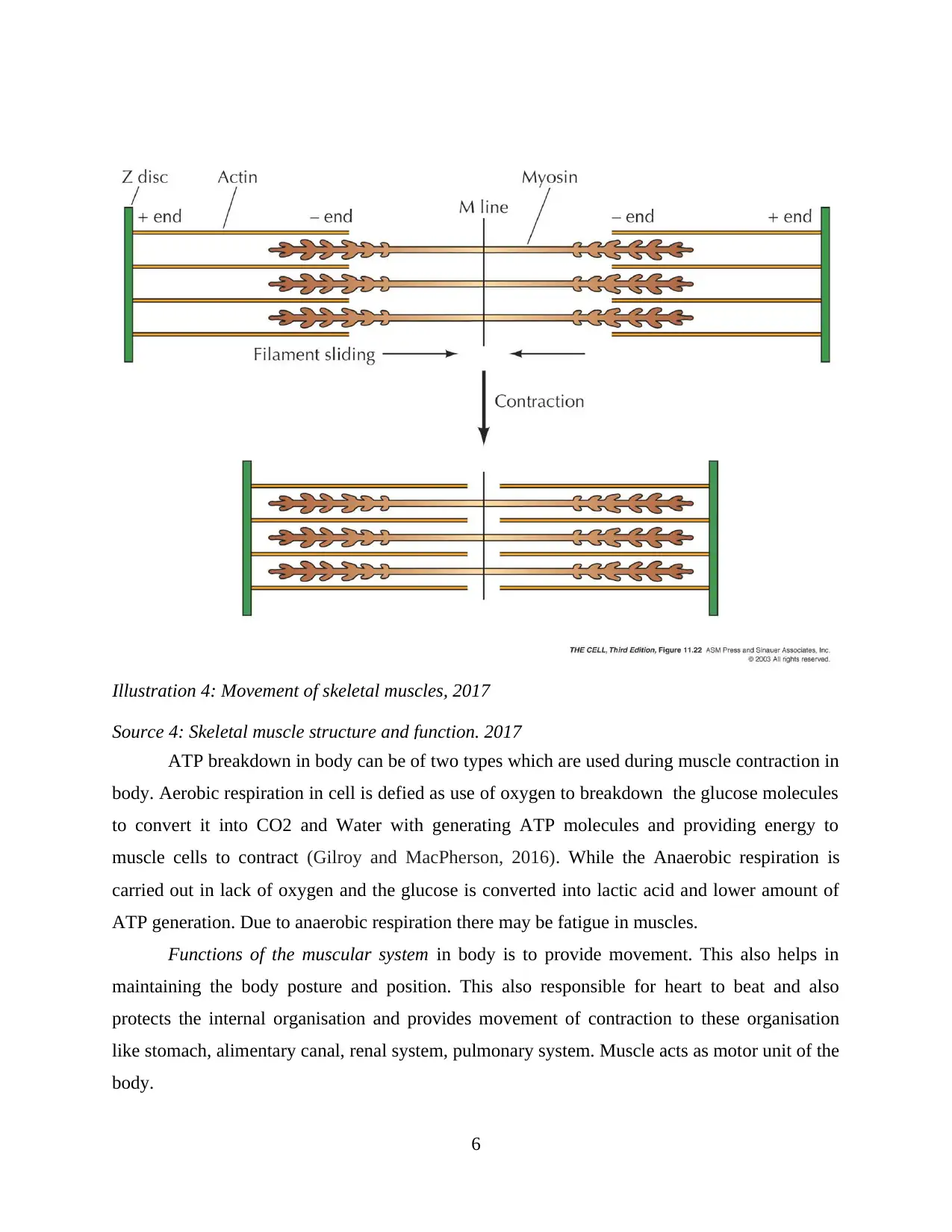
ATP breakdown in body can be of two types which are used during muscle contraction in
body. Aerobic respiration in cell is defied as use of oxygen to breakdown the glucose molecules
to convert it into CO2 and Water with generating ATP molecules and providing energy to
muscle cells to contract (Gilroy and MacPherson, 2016). While the Anaerobic respiration is
carried out in lack of oxygen and the glucose is converted into lactic acid and lower amount of
ATP generation. Due to anaerobic respiration there may be fatigue in muscles.
Functions of the muscular system in body is to provide movement. This also helps in
maintaining the body posture and position. This also responsible for heart to beat and also
protects the internal organisation and provides movement of contraction to these organisation
like stomach, alimentary canal, renal system, pulmonary system. Muscle acts as motor unit of the
body.
6
Illustration 4: Movement of skeletal muscles, 2017
Source 4: Skeletal muscle structure and function. 2017
body. Aerobic respiration in cell is defied as use of oxygen to breakdown the glucose molecules
to convert it into CO2 and Water with generating ATP molecules and providing energy to
muscle cells to contract (Gilroy and MacPherson, 2016). While the Anaerobic respiration is
carried out in lack of oxygen and the glucose is converted into lactic acid and lower amount of
ATP generation. Due to anaerobic respiration there may be fatigue in muscles.
Functions of the muscular system in body is to provide movement. This also helps in
maintaining the body posture and position. This also responsible for heart to beat and also
protects the internal organisation and provides movement of contraction to these organisation
like stomach, alimentary canal, renal system, pulmonary system. Muscle acts as motor unit of the
body.
6
Illustration 4: Movement of skeletal muscles, 2017
Source 4: Skeletal muscle structure and function. 2017
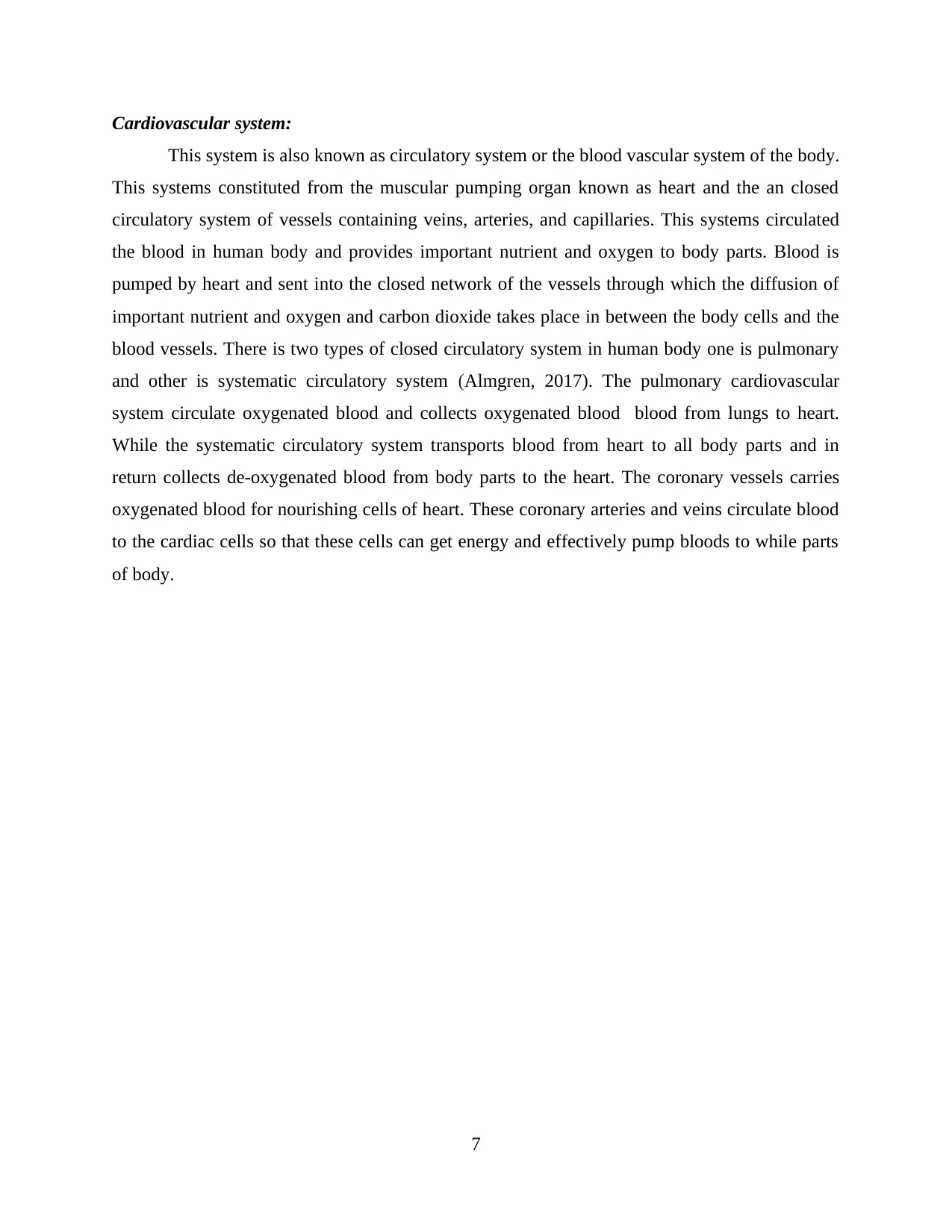
Cardiovascular system:
This system is also known as circulatory system or the blood vascular system of the body.
This systems constituted from the muscular pumping organ known as heart and the an closed
circulatory system of vessels containing veins, arteries, and capillaries. This systems circulated
the blood in human body and provides important nutrient and oxygen to body parts. Blood is
pumped by heart and sent into the closed network of the vessels through which the diffusion of
important nutrient and oxygen and carbon dioxide takes place in between the body cells and the
blood vessels. There is two types of closed circulatory system in human body one is pulmonary
and other is systematic circulatory system (Almgren, 2017). The pulmonary cardiovascular
system circulate oxygenated blood and collects oxygenated blood blood from lungs to heart.
While the systematic circulatory system transports blood from heart to all body parts and in
return collects de-oxygenated blood from body parts to the heart. The coronary vessels carries
oxygenated blood for nourishing cells of heart. These coronary arteries and veins circulate blood
to the cardiac cells so that these cells can get energy and effectively pump bloods to while parts
of body.
7
This system is also known as circulatory system or the blood vascular system of the body.
This systems constituted from the muscular pumping organ known as heart and the an closed
circulatory system of vessels containing veins, arteries, and capillaries. This systems circulated
the blood in human body and provides important nutrient and oxygen to body parts. Blood is
pumped by heart and sent into the closed network of the vessels through which the diffusion of
important nutrient and oxygen and carbon dioxide takes place in between the body cells and the
blood vessels. There is two types of closed circulatory system in human body one is pulmonary
and other is systematic circulatory system (Almgren, 2017). The pulmonary cardiovascular
system circulate oxygenated blood and collects oxygenated blood blood from lungs to heart.
While the systematic circulatory system transports blood from heart to all body parts and in
return collects de-oxygenated blood from body parts to the heart. The coronary vessels carries
oxygenated blood for nourishing cells of heart. These coronary arteries and veins circulate blood
to the cardiac cells so that these cells can get energy and effectively pump bloods to while parts
of body.
7
⊘ This is a preview!⊘
Do you want full access?
Subscribe today to unlock all pages.

Trusted by 1+ million students worldwide

Arteries are the blood vessels which are having thick elastic muscles lining the inner
tube. This supports the high pressure of blood in arteries and helps in circulating blood and
required amount of oxygen to every parts of body. Arteries carries oxygenated blood to the all
body parts from the heart except pulmonary arteries which carries de-oxygenated blood from
heart to lungs. While Veins carries de-oxygenated blood from all body parts to the heart and
heart send the blood to lungs so that all carbon dioxide can be diffused and again the blood gets
oxygenated (Keleher and MacDougall, 2015). Except pulmonary veins carries oxygenated blood
which transport from oxygenated blood from lungs to heart. Veins are having thin elastic walls
as pressure in venules are less as compared to the pressure in Arteries. Capillaries are small
blood vessel where actual diffusion of gases takes place between pulmonary cells or body cells
8
Illustration 5: Cardiovascular system, 2017
Source 5: Cardiovascular System. 2017.
tube. This supports the high pressure of blood in arteries and helps in circulating blood and
required amount of oxygen to every parts of body. Arteries carries oxygenated blood to the all
body parts from the heart except pulmonary arteries which carries de-oxygenated blood from
heart to lungs. While Veins carries de-oxygenated blood from all body parts to the heart and
heart send the blood to lungs so that all carbon dioxide can be diffused and again the blood gets
oxygenated (Keleher and MacDougall, 2015). Except pulmonary veins carries oxygenated blood
which transport from oxygenated blood from lungs to heart. Veins are having thin elastic walls
as pressure in venules are less as compared to the pressure in Arteries. Capillaries are small
blood vessel where actual diffusion of gases takes place between pulmonary cells or body cells
8
Illustration 5: Cardiovascular system, 2017
Source 5: Cardiovascular System. 2017.
Paraphrase This Document
Need a fresh take? Get an instant paraphrase of this document with our AI Paraphraser
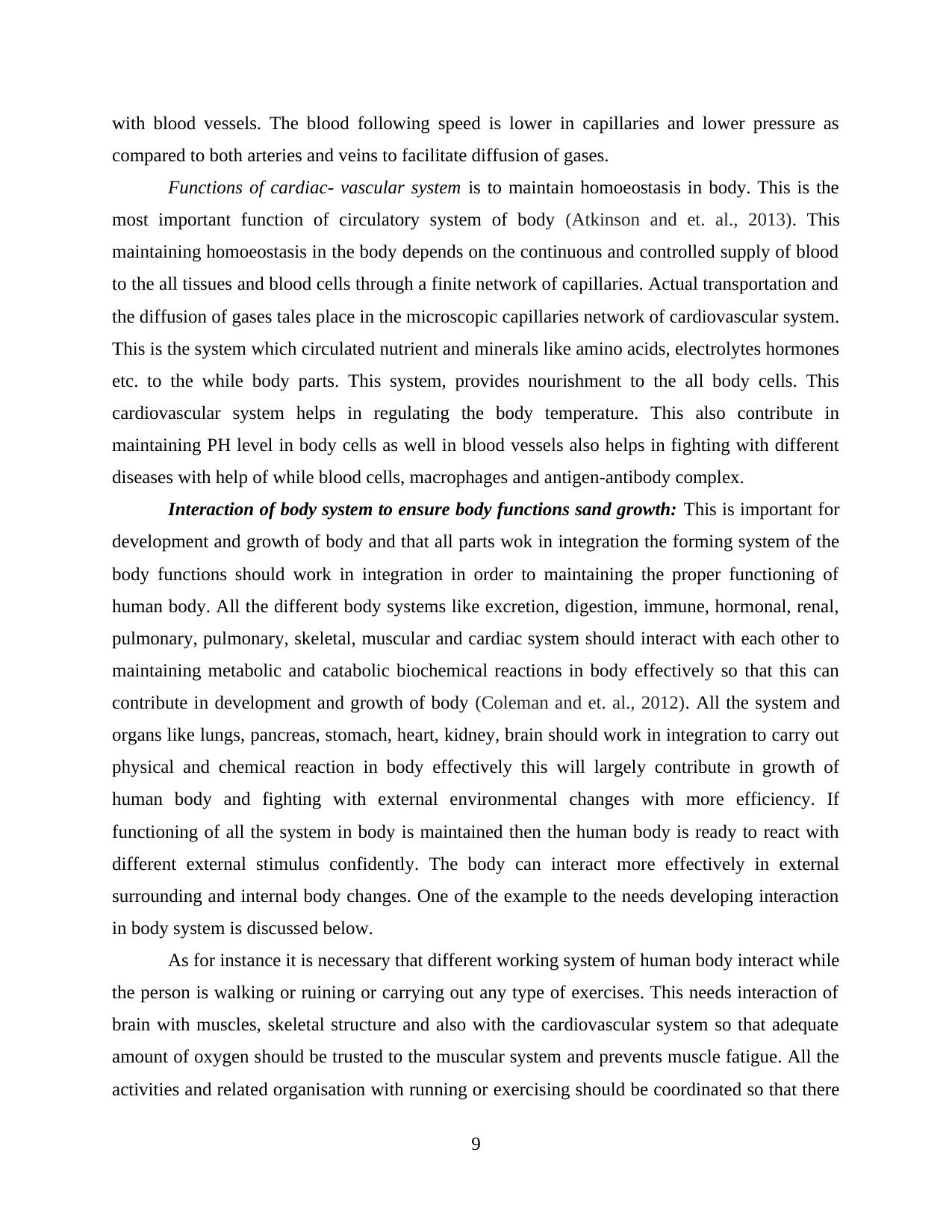
with blood vessels. The blood following speed is lower in capillaries and lower pressure as
compared to both arteries and veins to facilitate diffusion of gases.
Functions of cardiac- vascular system is to maintain homoeostasis in body. This is the
most important function of circulatory system of body (Atkinson and et. al., 2013). This
maintaining homoeostasis in the body depends on the continuous and controlled supply of blood
to the all tissues and blood cells through a finite network of capillaries. Actual transportation and
the diffusion of gases tales place in the microscopic capillaries network of cardiovascular system.
This is the system which circulated nutrient and minerals like amino acids, electrolytes hormones
etc. to the while body parts. This system, provides nourishment to the all body cells. This
cardiovascular system helps in regulating the body temperature. This also contribute in
maintaining PH level in body cells as well in blood vessels also helps in fighting with different
diseases with help of while blood cells, macrophages and antigen-antibody complex.
Interaction of body system to ensure body functions sand growth: This is important for
development and growth of body and that all parts wok in integration the forming system of the
body functions should work in integration in order to maintaining the proper functioning of
human body. All the different body systems like excretion, digestion, immune, hormonal, renal,
pulmonary, pulmonary, skeletal, muscular and cardiac system should interact with each other to
maintaining metabolic and catabolic biochemical reactions in body effectively so that this can
contribute in development and growth of body (Coleman and et. al., 2012). All the system and
organs like lungs, pancreas, stomach, heart, kidney, brain should work in integration to carry out
physical and chemical reaction in body effectively this will largely contribute in growth of
human body and fighting with external environmental changes with more efficiency. If
functioning of all the system in body is maintained then the human body is ready to react with
different external stimulus confidently. The body can interact more effectively in external
surrounding and internal body changes. One of the example to the needs developing interaction
in body system is discussed below.
As for instance it is necessary that different working system of human body interact while
the person is walking or ruining or carrying out any type of exercises. This needs interaction of
brain with muscles, skeletal structure and also with the cardiovascular system so that adequate
amount of oxygen should be trusted to the muscular system and prevents muscle fatigue. All the
activities and related organisation with running or exercising should be coordinated so that there
9
compared to both arteries and veins to facilitate diffusion of gases.
Functions of cardiac- vascular system is to maintain homoeostasis in body. This is the
most important function of circulatory system of body (Atkinson and et. al., 2013). This
maintaining homoeostasis in the body depends on the continuous and controlled supply of blood
to the all tissues and blood cells through a finite network of capillaries. Actual transportation and
the diffusion of gases tales place in the microscopic capillaries network of cardiovascular system.
This is the system which circulated nutrient and minerals like amino acids, electrolytes hormones
etc. to the while body parts. This system, provides nourishment to the all body cells. This
cardiovascular system helps in regulating the body temperature. This also contribute in
maintaining PH level in body cells as well in blood vessels also helps in fighting with different
diseases with help of while blood cells, macrophages and antigen-antibody complex.
Interaction of body system to ensure body functions sand growth: This is important for
development and growth of body and that all parts wok in integration the forming system of the
body functions should work in integration in order to maintaining the proper functioning of
human body. All the different body systems like excretion, digestion, immune, hormonal, renal,
pulmonary, pulmonary, skeletal, muscular and cardiac system should interact with each other to
maintaining metabolic and catabolic biochemical reactions in body effectively so that this can
contribute in development and growth of body (Coleman and et. al., 2012). All the system and
organs like lungs, pancreas, stomach, heart, kidney, brain should work in integration to carry out
physical and chemical reaction in body effectively this will largely contribute in growth of
human body and fighting with external environmental changes with more efficiency. If
functioning of all the system in body is maintained then the human body is ready to react with
different external stimulus confidently. The body can interact more effectively in external
surrounding and internal body changes. One of the example to the needs developing interaction
in body system is discussed below.
As for instance it is necessary that different working system of human body interact while
the person is walking or ruining or carrying out any type of exercises. This needs interaction of
brain with muscles, skeletal structure and also with the cardiovascular system so that adequate
amount of oxygen should be trusted to the muscular system and prevents muscle fatigue. All the
activities and related organisation with running or exercising should be coordinated so that there
9
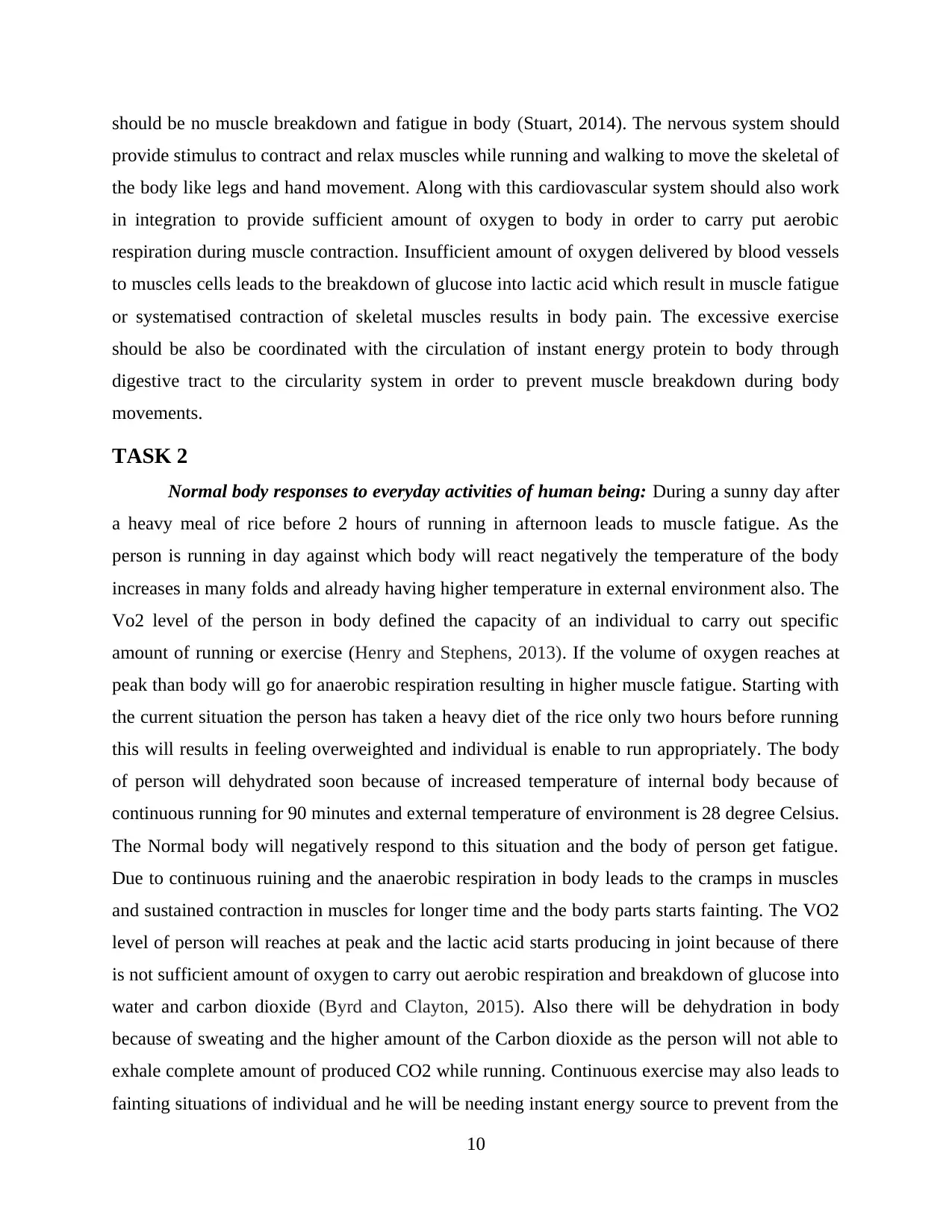
should be no muscle breakdown and fatigue in body (Stuart, 2014). The nervous system should
provide stimulus to contract and relax muscles while running and walking to move the skeletal of
the body like legs and hand movement. Along with this cardiovascular system should also work
in integration to provide sufficient amount of oxygen to body in order to carry put aerobic
respiration during muscle contraction. Insufficient amount of oxygen delivered by blood vessels
to muscles cells leads to the breakdown of glucose into lactic acid which result in muscle fatigue
or systematised contraction of skeletal muscles results in body pain. The excessive exercise
should be also be coordinated with the circulation of instant energy protein to body through
digestive tract to the circularity system in order to prevent muscle breakdown during body
movements.
TASK 2
Normal body responses to everyday activities of human being: During a sunny day after
a heavy meal of rice before 2 hours of running in afternoon leads to muscle fatigue. As the
person is running in day against which body will react negatively the temperature of the body
increases in many folds and already having higher temperature in external environment also. The
Vo2 level of the person in body defined the capacity of an individual to carry out specific
amount of running or exercise (Henry and Stephens, 2013). If the volume of oxygen reaches at
peak than body will go for anaerobic respiration resulting in higher muscle fatigue. Starting with
the current situation the person has taken a heavy diet of the rice only two hours before running
this will results in feeling overweighted and individual is enable to run appropriately. The body
of person will dehydrated soon because of increased temperature of internal body because of
continuous running for 90 minutes and external temperature of environment is 28 degree Celsius.
The Normal body will negatively respond to this situation and the body of person get fatigue.
Due to continuous ruining and the anaerobic respiration in body leads to the cramps in muscles
and sustained contraction in muscles for longer time and the body parts starts fainting. The VO2
level of person will reaches at peak and the lactic acid starts producing in joint because of there
is not sufficient amount of oxygen to carry out aerobic respiration and breakdown of glucose into
water and carbon dioxide (Byrd and Clayton, 2015). Also there will be dehydration in body
because of sweating and the higher amount of the Carbon dioxide as the person will not able to
exhale complete amount of produced CO2 while running. Continuous exercise may also leads to
fainting situations of individual and he will be needing instant energy source to prevent from the
10
provide stimulus to contract and relax muscles while running and walking to move the skeletal of
the body like legs and hand movement. Along with this cardiovascular system should also work
in integration to provide sufficient amount of oxygen to body in order to carry put aerobic
respiration during muscle contraction. Insufficient amount of oxygen delivered by blood vessels
to muscles cells leads to the breakdown of glucose into lactic acid which result in muscle fatigue
or systematised contraction of skeletal muscles results in body pain. The excessive exercise
should be also be coordinated with the circulation of instant energy protein to body through
digestive tract to the circularity system in order to prevent muscle breakdown during body
movements.
TASK 2
Normal body responses to everyday activities of human being: During a sunny day after
a heavy meal of rice before 2 hours of running in afternoon leads to muscle fatigue. As the
person is running in day against which body will react negatively the temperature of the body
increases in many folds and already having higher temperature in external environment also. The
Vo2 level of the person in body defined the capacity of an individual to carry out specific
amount of running or exercise (Henry and Stephens, 2013). If the volume of oxygen reaches at
peak than body will go for anaerobic respiration resulting in higher muscle fatigue. Starting with
the current situation the person has taken a heavy diet of the rice only two hours before running
this will results in feeling overweighted and individual is enable to run appropriately. The body
of person will dehydrated soon because of increased temperature of internal body because of
continuous running for 90 minutes and external temperature of environment is 28 degree Celsius.
The Normal body will negatively respond to this situation and the body of person get fatigue.
Due to continuous ruining and the anaerobic respiration in body leads to the cramps in muscles
and sustained contraction in muscles for longer time and the body parts starts fainting. The VO2
level of person will reaches at peak and the lactic acid starts producing in joint because of there
is not sufficient amount of oxygen to carry out aerobic respiration and breakdown of glucose into
water and carbon dioxide (Byrd and Clayton, 2015). Also there will be dehydration in body
because of sweating and the higher amount of the Carbon dioxide as the person will not able to
exhale complete amount of produced CO2 while running. Continuous exercise may also leads to
fainting situations of individual and he will be needing instant energy source to prevent from the
10
⊘ This is a preview!⊘
Do you want full access?
Subscribe today to unlock all pages.

Trusted by 1+ million students worldwide
1 out of 20
Related Documents
Your All-in-One AI-Powered Toolkit for Academic Success.
+13062052269
info@desklib.com
Available 24*7 on WhatsApp / Email
![[object Object]](/_next/static/media/star-bottom.7253800d.svg)
Unlock your academic potential
Copyright © 2020–2025 A2Z Services. All Rights Reserved. Developed and managed by ZUCOL.





